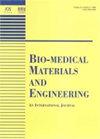Effect of casein phosphopeptide amorphous calcium fluoride phosphate and calcium glycerophosphate on incisors with molar-incisor hypomineralization: A cross-over, randomized clinical trial.
IF 1
4区 医学
Q4 ENGINEERING, BIOMEDICAL
引用次数: 3
Abstract
BACKGROUND Within the scope of minimally invasive dentistry, the use of different biocompatible remineralization agents on incisors affected by molar-incisor hypomineralization (MIH) gains importance. OBJECTIVE To evaluate the effect of casein phosphopeptide amorphous calcium fluoride phosphate (CPP-ACFP) and calcium glycerophosphate (CaGP) in mineral density (MD) of white/creamy and yellow/brown demarcated opacities on incisors affected by MIH by means laser fluorescence (LF). METHODS As a cross-over, randomized trial, twenty-two children with 167 incisors affected by MIH were recruited and randomly assigned to one of the two different agents and crossed over to other agents with two weeks washout in between. Incisors were examined by using LF at all before and after three months periods. RESULTS The results of the paired t-tests for determining the period effect between the baseline findings showed significant difference in white/creamy and yellow/brown demarcated opacities of LF values for both groups (p < 0.05). The difference between both groups according to after categorization of 20% increasing in MD in the percent of change before and after application on LF values; was not found statistically significant in white/creamy (p = 0.970) and yellow/brown (p = 0.948) opacities. CONCLUSIONS The primary outcome was CPP-ACFP and CaGP had a positive effect in decreasing hypomineralization on MIH-affected enamel for three months period.酪蛋白磷酸肽、无定形氟化钙磷酸盐和甘油磷酸钙对臼齿-门牙低矿化的影响:一项交叉、随机临床试验。
背景在微创牙科的范围内,对受磨牙-切牙矿化不足(MIH)影响的切牙使用不同的生物相容性再矿化剂变得越来越重要。目的用激光荧光法(LF)评价酪蛋白磷酸肽无定形磷酸钙(CPP-ACFP)和甘油磷酸钙(CaGP)对MIH影响的切牙白色/乳白色和黄色/棕色界限混浊的矿物密度(MD)的影响,22名患有167颗门牙的儿童被招募,随机分配到两种不同的药剂中的一种,并在两周的时间内转移到其他药剂中。在三个月前后使用LF检查切口。结果用于确定基线结果之间的周期效应的配对t检验结果显示,两组LF值的白色/乳白色和黄色/棕色界限混浊度存在显著差异(p<0.05)。根据分类后,两组之间的差异是,在应用LF值前后,MD的变化百分比增加了20%;在白色/乳白色(p=0.970)和黄色/棕色(p=0.948)的混浊中没有发现统计学意义。结论:主要结果是在三个月的时间里,CPP-ACFP和CaGP在减少MIH影响的釉质的低矿化方面具有积极作用。
本文章由计算机程序翻译,如有差异,请以英文原文为准。
求助全文
约1分钟内获得全文
求助全文
来源期刊

Bio-medical materials and engineering
工程技术-材料科学:生物材料
CiteScore
1.80
自引率
0.00%
发文量
73
审稿时长
6 months
期刊介绍:
The aim of Bio-Medical Materials and Engineering is to promote the welfare of humans and to help them keep healthy. This international journal is an interdisciplinary journal that publishes original research papers, review articles and brief notes on materials and engineering for biological and medical systems. Articles in this peer-reviewed journal cover a wide range of topics, including, but not limited to: Engineering as applied to improving diagnosis, therapy, and prevention of disease and injury, and better substitutes for damaged or disabled human organs; Studies of biomaterial interactions with the human body, bio-compatibility, interfacial and interaction problems; Biomechanical behavior under biological and/or medical conditions; Mechanical and biological properties of membrane biomaterials; Cellular and tissue engineering, physiological, biophysical, biochemical bioengineering aspects; Implant failure fields and degradation of implants. Biomimetics engineering and materials including system analysis as supporter for aged people and as rehabilitation; Bioengineering and materials technology as applied to the decontamination against environmental problems; Biosensors, bioreactors, bioprocess instrumentation and control system; Application to food engineering; Standardization problems on biomaterials and related products; Assessment of reliability and safety of biomedical materials and man-machine systems; and Product liability of biomaterials and related products.
 求助内容:
求助内容: 应助结果提醒方式:
应助结果提醒方式:


